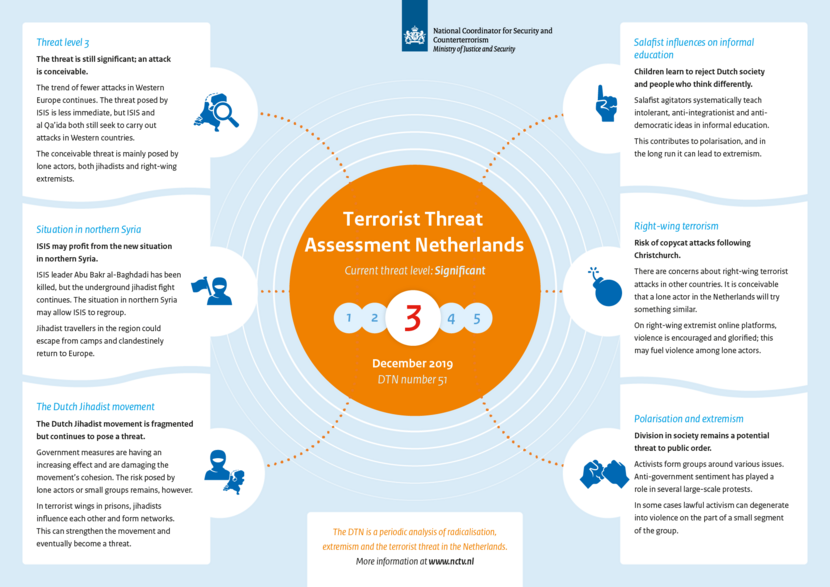Threat level lowered to 3; attack in the Netherlands conceivable
The National Coordinator for Security and Counterterrorism (NCTV) has determined the terrorism threat level to be 3 on a scale of 1 to 5, which means that the possibility of a terrorist attack is significant. At the time of the previous threat assessment the level was 4. Since the end of 2017, the threat to the Netherlands has changed. Jihadist attacks are still being carried out sporadically in the West, but the situation is different from the 2015-2017 period, when dozens of attacks were occurring in Europe every year. The fact that this change seems to be continuing in the longer term prompted the lowering of the threat level. This is the key conclusion of the 51st edition of the Terrorist Threat Assessment for the Netherlands (DTN51), published by the NCTV.
Attacks remain conceivable
Threat level 3 means that an attack in the Netherlands is still conceivable. There is a jihadist movement in the Netherlands that comprises individuals who pose a terrorist threat. This was evident, for instance, from the arrest on 25 November 2019 of two men from Zoetermeer on suspicion of preparing a terrorist attack. However, the jihadist movement does appear to be increasingly affected by repressive government measures.
It is also conceivable that the Netherlands could be the target of an attack by ISIS or al Qa’ida, planned abroad. It is therefore important for the security services to remain alert to terrorist threats.
Context of the threat level
In March 2013 the threat level was raised from 2 to 3 on a scale of 1 to 4. That was at the time of the Syrian civil war, which led to the emergence of ISIS and a sharp increase in the number of jihadist travellers from all over Europe. This was followed by a period in which a large number of attacks were carried out in and against the West, including the major attacks in Paris (November 2015) and Brussels (March 2016). In order to create a more nuanced system of threat levels, in July 2016 a level was added, and since then the threat level had been 4 on a scale of 1 to 5. The only exception was on 18 March 2019, after the attack on a tram in Utrecht, when the level was raised to 5 for several hours throughout Utrecht province. The changed threat assessment has now prompted a lowering of the threat level to 3: significant.
Right-wing terrorism
Although the main threat to the Netherlands is posed by the jihadist movement, a right-wing terrorist attack is also conceivable. Right-wing extremist groups are scarcely organised, but it is possible that a lone actor could become radicalised and commit an act of violence inspired by right-wing extremism. Copycat behaviour is also a risk; the attacks in Christchurch in March 2019 inspired others to carry out attacks too, such as the one in El Paso. It should be noted, however, that right-wing terrorist violence in other European countries does not automatically lead to attacks in the Netherlands.
Extremism and polarisation
In a new development, certain left-wing extremist activist groups that used to focus on other areas – such as anti-fascism and asylum and immigration policy – are adopting the narrative and strategy of climate activism groups. This mainly leads to lawful resistance by people who swear off violence, but are nevertheless prepared to break the law. The threat assessment also identifies various developments that have polarised society. For instance, the NCTV does not expect the Black Pete debate to die down in the coming years. As regards the ‘burka ban’, emotions ran high, but this was mainly online. A third development is the role that anti-government sentiment played in several large-scale demonstrations.
The video below is subtitled in English.
What is happening in the Netherlands with regard to radicalisation and extremism? And what terrorist threats does the Netherlands face? These questions are answered three times a year in the Terrorist Threat Assessment for the Netherlands: The DTN.
The National Coordinator for Security and Counterterrorism, the NCTV, draws up the DTN on the basis of information from the intelligence and security services, the police, Dutch embassies, and open sources such as the media and the internet.
The analysis presented in the DTN is used to set a threat level: an assessment of the risk of a terrorist attack taking place in the Netherlands. When the first DTN was published in 2005 there were four threat levels. A fifth was added in 2016.
Only once, on 18 March 2019, in the hours immediately following the attack on a tram in Utrecht, has the threat level been raised to level 5, the highest level, and only for the province of Utrecht.
The most recent DTN analysis sets the terrorist threat in the Netherlands at significant: level 3.
At english.nctv.nl, everyone can read the DTN and see what developments have led to the current threat level.
